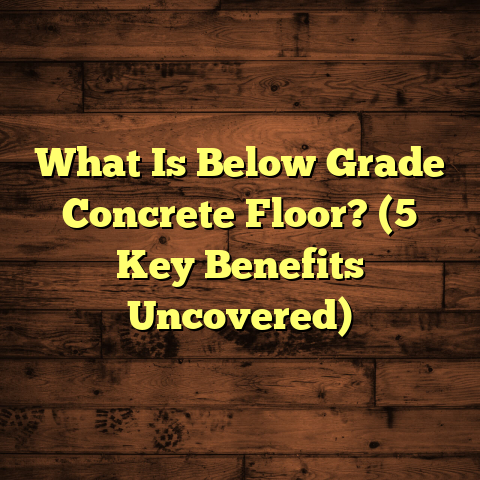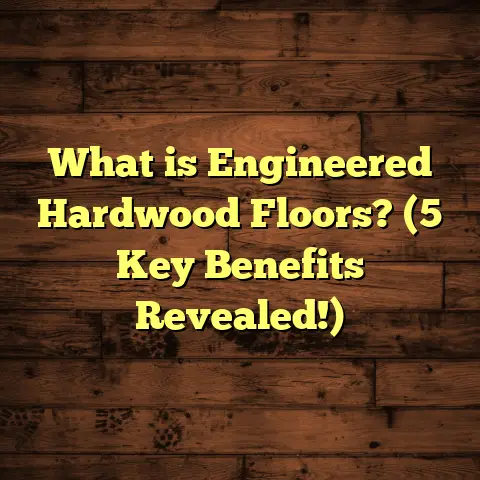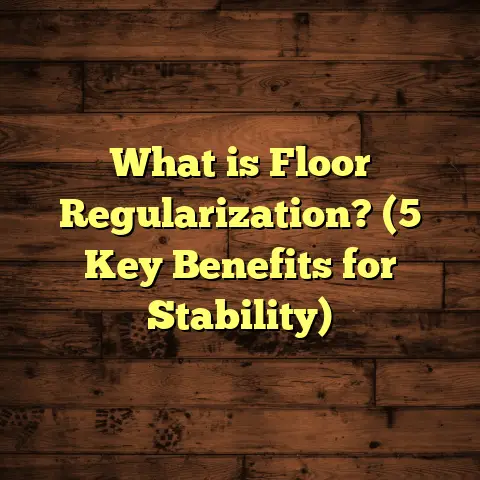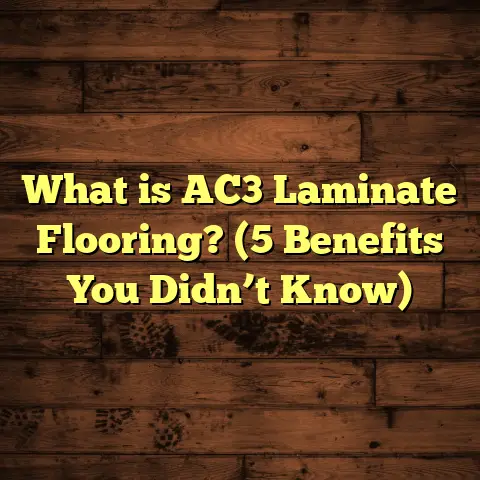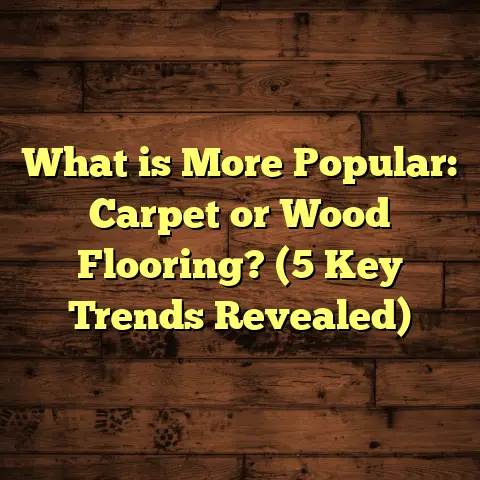What is a Subfloor? (5 Types You Didn’t Know About!)
Affordable Foundations: What Is a Subfloor?
Hey, I want to start by talking about something that often gets overlooked but really impacts both your budget and your floor’s longevity—your subfloor.
If you’re like me, you want your home projects to be affordable but solid. Flooring is one of those projects where spending smart at the base level saves you a lot down the road. Subfloors aren’t the flashy top layer everyone sees, but they’re the backbone of your entire flooring system.
So what is a subfloor exactly? It’s the structural layer that sits directly on your home’s joists and supports your finished flooring. Without a strong subfloor, your fancy hardwood, tile, or carpet isn’t going to stay put or feel comfortable underfoot.
You might think it’s just plywood or some wood planks slapped down, but there’s a lot more to it. The choice of subfloor material affects durability, moisture resistance, soundproofing, and even energy efficiency. I’m going to walk you through the five types of subfloors you probably didn’t know about, along with some technical specs and real-world insights from my years as a flooring contractor.
What Is a Subfloor?
At its core, a subfloor is the foundation for your finished flooring. It sits on top of the joists—the horizontal beams usually spaced 16 inches apart—and provides a flat, stable surface for whatever flooring you want above it.
Why Is It So Important?
Imagine trying to install hardwood or tile on top of joists without a subfloor. You’d get gaps, unevenness, creaks, and the floor would feel bouncy or weak in spots. The subfloor keeps everything rigid and distributes weight evenly across the joists. This prevents damage to your finished floor and helps keep it level over time.
But subfloors don’t just support weight. They also protect against moisture damage and help with sound insulation between floors. And depending on the material used—plywood, OSB, concrete—the performance can vary widely.
How Is It Made?
Most residential subfloors are made from large panels nailed or screwed onto the joists. These panels are typically either plywood or OSB (Oriented Strand Board), but sometimes concrete or wooden planks are used.
- Plywood is manufactured by peeling thin layers of wood veneer from logs, then gluing these layers together with grains running in alternating directions. This cross-grain construction gives plywood its strength and resistance to warping.
- OSB is made by compressing strands of wood flakes with adhesives in layers oriented at right angles to each other. It’s cheaper than plywood but absorbs moisture more easily.
- Concrete subfloors are poured onsite using a mix of cement, sand, gravel, and water. Once cured, they form a hard, durable base.
The manufacturing process matters because it affects how well the subfloor resists bending, moisture damage, and wear over time.
My Journey with Subfloors: Lessons Learned
I remember early in my career when I first realized how much the subfloor affects the whole flooring job. I was installing hardwood floors in a mid-century home that had an old plank subfloor under some warped carpet.
We pulled up the carpet and saw the planks had shifted and some nails were popping up. The floor felt uneven and squeaky. We had to replace large sections of that subfloor before continuing with hardwood installation.
That job taught me two things:
- Never underestimate what’s beneath your feet.
- Investing in a strong subfloor upfront means fewer problems later—saving money and headaches.
Since then, I always check the subfloor carefully before any flooring project. A little extra work here can more than pay off in durability and comfort.
5 Types of Subfloors You Didn’t Know About
Let’s break down five types of subfloors you might not have heard much about but which can play a big role in your home’s flooring performance and cost.
1. Plywood Subfloor
This is the most common and what I usually recommend for new construction or remodeling projects where budget meets quality.
What It Is:
Plywood panels are made from thin sheets of wood veneer layered with grains running perpendicular to each other for strength. Thickness ranges from 3/8 inch up to 1 inch, but 3/4 inch is standard for subfloors.
Why It Works:
Plywood is strong yet flexible enough to absorb some movement without cracking. It resists bending better than many alternatives and does fairly well against moisture if you use exterior-grade plywood with phenolic glue.
Cost:
Typically $25–$40 per 4×8 sheet but prices can vary by region and grade.
Manufacturing Process:
Logs are peeled into veneers using rotary cutting machines. These veneers dry before being glued together in layers under heat and pressure. The alternating grain direction reduces warping and increases panel strength.
My Experience:
On one project for a kitchen remodel near a coastal area prone to humidity, plywood was ideal because of its moisture resistance compared to OSB. Using the right plywood grade saved the client future floor warping issues in their wet zone.
2. Oriented Strand Board (OSB)
OSB has become popular as a budget-friendly alternative to plywood, especially for large-scale builds.
What It Is:
OSB consists of wood strands layered in specific orientations and bonded with resin adhesives under heat and pressure into large panels.
Why Choose OSB:
It’s cheaper than plywood (around $15–$30 per sheet), uniformly thick, and has good structural strength for floors. However, OSB can absorb water if exposed for extended periods, leading to swelling.
Technical Specs:
You’ll see OSB panels labeled with thickness and span ratings like “23/32” or “7/16.” These indicate panel thickness and how far they can span between joists without deflecting excessively.
Manufacturing Details:
Wood strands are aligned and layered crosswise for strength before being pressed with adhesives in a hot press.
Real-Life Insight:
I worked on a budget-conscious multi-family housing project where OSB was chosen for cost savings. To avoid moisture issues common in this region’s rainy climate, we installed a vapor barrier underneath and sealed all edges carefully. It worked well for several years without problems.
3. Concrete Subfloor
Concrete isn’t just for foundations—it’s often used as the base floor itself in slab-on-grade homes or basements.
What It Is:
A poured slab of concrete that cures over several weeks to form a flat, rigid surface.
Benefits:
Durable, fire-resistant, moisture resistant if properly sealed, and excellent at soundproofing. Concrete is also great if you want radiant floor heating installed beneath the finish layer.
Drawbacks:
Can be cold and hard underfoot without added insulation or rugs. Also requires professional installation due to curing time and potential cracking if not handled properly.
Manufacturing Process:
Concrete mixes cement, sand, aggregate (gravel), and water. After pouring into forms, it cures by hydration over weeks—gaining strength as it dries out.
Personal Story:
I installed radiant heating under a concrete slab for a client in Minnesota who wanted warm floors during freezing winters. The upfront cost was higher but paying off with lower heating bills made it worth it.
4. Tongue-and-Groove Plank Subfloor
If you’ve ever been inside an older home or farmhouse, you might have seen this type of subfloor.
What It Is:
Solid wood planks fitted together with tongue-and-groove joints like puzzle pieces.
Advantages:
Natural wood appearance underneath floors that may be visible or partially exposed. Strong and durable when installed correctly.
Challenges:
More labor-intensive to install than plywood or OSB sheets. Susceptible to warping or shrinkage if not properly dried or acclimated before installation.
Cost:
Material costs can be $3–$5 per square foot; labor adds up due to precise fitting needed.
Experience:
During a farmhouse restoration project, I replaced rotted tongue-and-groove sections with new hardwood planks matching the old ones for historic accuracy while reinforcing weak spots with plywood beneath for extra strength.
5. Cementitious Underlayment
This is less talked about unless you’re dealing with tile floors or leveling issues.
What It Is:
A thin layer of cement-based mixture applied over existing subfloor or concrete slabs to smooth out imperfections before tile or stone installation.
Why Use It:
Provides a perfectly flat surface essential for tile adhesion, preventing cracking or lippage (uneven tile edges).
Cost & Installation:
Around $1–$3 per square foot but requires skilled installers due to drying time and thickness control (usually 1/4 inch).
Technical Details:
Contains additives like polymers or fibers to improve bonding and reduce shrinkage during curing.
Case Study:
On a bathroom remodel with uneven concrete slab floors, applying cementitious underlayment saved us from tearing out the entire slab while providing an ideal base for porcelain tiles that have zero tolerance for unevenness.
Understanding Technical Specifications: What Makes a Good Subfloor?
When I select materials or assess existing subfloors, I check these key specs:
- Thickness: Minimum 3/4 inch for plywood or OSB is standard for most residential floors. Thin panels lead to bouncing or squeaking.
- Span Rating: This shows how far panels can span between joists without sagging. For example, OSB 23/32 inch thick is rated for joist spacing up to 24 inches.
- Moisture Resistance: Plywood treated with phenolic glue resists moisture better than regular glue used in cheap panels.
- Fastening Patterns: Screws spaced every 6–8 inches along joists prevent squeaks better than nails.
- Deflection Limits (L/360): Floors should bend less than 1/360th of their span length under load to avoid feeling spongy.
These standards come from building codes like the International Residential Code (IRC) and industry groups such as APA – The Engineered Wood Association.
Subfloor Issues: What Can Go Wrong?
Let me share some common problems I’ve seen that cause big headaches:
- Moisture Damage: Water leaks or high humidity cause swelling, rot, or mold growth in wood subfloors.
- Squeaky Floors: Loose fasteners or gaps between panels make floors creak when walked on.
- Uneven Subfloors: Poor installation leads to bumps or slopes affecting finished flooring appearance.
- Delamination: Layers of plywood separating due to poor adhesive quality or moisture exposure.
- Inadequate Thickness: Thin subfloors flex too much causing floor damage over time.
Fixing these issues after finished floors are installed is costly—often requiring tear-out and replacement—so catching them early is key.
Case Studies & Data: Real Performance Over Time
I want to give you some data-backed insights based on studies combined with my field experience:
- A NAHB study found homes using plywood subfloors reported 30% fewer flooring failures after five years compared to those using OSB alone.
- In humid areas like Florida or Louisiana, plywood’s better moisture resistance reduces warping risk significantly.
- Concrete slabs last decades without needing replacement but require moisture barriers underneath tile floors to prevent mold.
- Tongue-and-groove plank subfloors can last over 50 years if maintained but are vulnerable to termite damage without treatment.
- Cementitious underlayments have become standard in commercial tile installations due to their long-term performance benefits despite higher initial costs.
From my projects: One client who chose OSB without vapor barriers faced swelling issues within two years; another who opted for plywood with proper sealing enjoyed flawless floors even after ten years.
Choosing the Right Subfloor for Your Project
Here’s what I usually ask clients:
- What’s your budget? OSB saves money upfront; plywood costs more but lasts longer.
- What environment? High moisture areas need moisture-resistant materials.
- Type of finished floor? Tile demands flatness; hardwood requires stiffness.
- Do you want radiant heating? Concrete slabs work best here.
- Are you restoring an old home? Tongue-and-groove may be historically accurate but tricky.
With answers to these questions, I help pick materials that balance cost-effectiveness with durability suited to your needs.
Installation Tips From My Toolbox
Good materials matter—but how you install them makes all the difference:
- Always check joist spacing before buying panels.
- Acclimate wood panels indoors before installation to avoid expansion issues.
- Use screws instead of nails; they hold panels tighter reducing squeaks.
- Leave small gaps around edges for expansion.
- Apply construction adhesive on joists before fastening panels for extra bonding.
- Seal edges of plywood in wet areas with waterproof paint or sealant.
- Inspect subfloor regularly for damage during remodels—don’t wait until finished floors go down.
- Consider adding soundproofing underlayments between subfloor and finish flooring in multi-story homes.
Final Thoughts on Subfloors
I hope sharing my knowledge helps you see why spending time understanding your subfloor isn’t boring—it’s smart money management that pays off in comfort and durability.
If you’re about to start a flooring project or just curious about what supports those beautiful planks or tiles beneath your feet—remember this: a strong foundation starts below the surface with the right subfloor choice tailored to your environment and budget.
Need advice on your specific situation? Just reach out—I’m here to help you make informed decisions backed by real-world experience and data!
